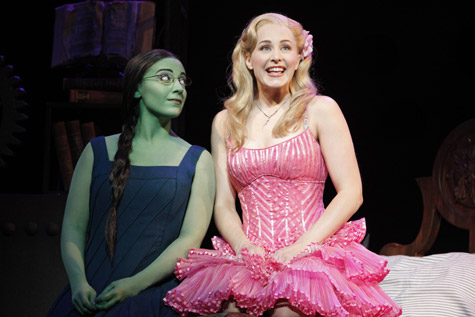
WITCHY WOMEN Vivino and Schwartz. |
From L. Frank Baum's 1900 book The Wonderful Wizard of Oz came the 1939 film; from Gregory Maguire's 1995 book Wicked came the 2003 Broadway hit of the same name. That span of more than a century has embedded the story in the American psyche, never more evident than in the multi-generational audience that filled the Providence Performing Arts Center for the opening of Wicked (through January 10).
Both Maguire and the writers of the musical (book by Winnie Holzman, music and lyrics by Stephen Schwartz) tell the back story of the Wicked Witch of the West, though the play tightens its focus on the friendship between Glinda (the "good witch") and the "wicked witch" Elphaba, named from Baum's "L," "F" (Frank), and "Ba" (Baum). The unlikely pair meet at college, where Elphaba (Donna Vivino) arrives with her wheelchair-bound sister Nessarose (Brynn O'Malley), aka Witch of the East, who later gets felled by Dorothy's house.
Elphaba was born green (due to an elixir her mother drank while pregnant). Her mother (Lauren Masiello) was fed another herb to ward off "greenness" during her second pregnancy, but unfortunately it killed her and crippled her child, leaving an embittered widower (Kevin McMahon) to raise both girls. Are you beginning to grasp the heavy shadow of guilt Elphaba lives under? Not to mention the ever-present cloud of prejudice against her verdigris skin — Glinda (Chandra Lee Schwartz) initially mocks her anger with "the artichoke is steamed!"
Wicked is a grand spectacle of sights and sound (it won Tony Awards for costume designer Susan Hilferty, Providence's own scenic designer Eugene Lee, and the actor who played Elphaba, Idina Menzel), but at the heart of the show are the questions it asks: What are the roots of evil? How do you define wickedness? What are the most important tenets of friendship? What happens when those become diverted by jealousy and self-absorption? How do the transgressions of the past come back to haunt you or your children?
Lee's set is a kaleidoscope of clockwork gears that spin and turn and open out to a distant townscape or drop down with Glinda riding on a large wheel or move inward to frame a scene. Each succeeding set change adds layers of symbolism to the narrative. The clock dials remind us of the flashback through which Glinda is relating her memories of Elphaba, after the play opens with "No One Mourns the Wicked" (i.e., the Wicked Witch is dead). The bridge provides a romantic rendezvous for Glinda and Prince Fiyero (Richard H. Blake). And then there's the castle tower, a dreamlike re-imagining from the film.
Hilferty's costumes all but steal the show. Her "twisted Edwardian" outfits on the Munchkins have off-center bustles, off-kilter hats, outrageous color combinations, no two costumes alike. The college clothing emphasizes navy blue stripes but everything is mixed and matched in the most unusual ways. Ditto for the black-on-white "Dancing Through Life" piece, with dots and stripes in tights, skirts, and headpieces. And this is all before the extravaganza of greens worn by Emerald City residents.